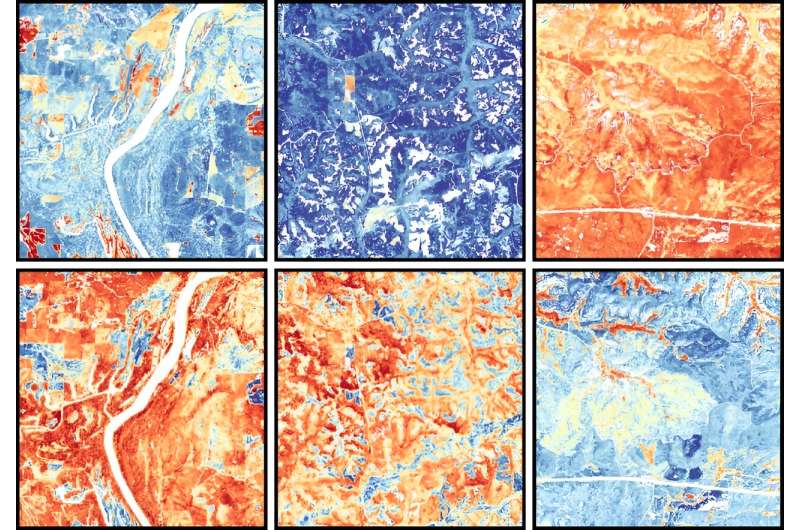This article has been reviewed according to Science X's editorial process and policies. Editors have highlighted the following attributes while ensuring the content's credibility:
fact-checked
trusted source
proofread
Mapping plant functional diversity from space: Ecosystem monitoring with novel field-satellite integration

An international team of researchers, led by Professor Jin Wu from the School of Biological Sciences at The University of Hong Kong (HKU), has made a promising advancement in mapping plant functional traits from space using time-series satellite data. The study, published in Remote Sensing of Environment, showcases the innovative combination of the Sentinel-2 satellite mission and its dynamic time-series capabilities.
This innovative approach not only unlocks a deeper understanding of essential foliar traits, providing crucial insights into the functional diversity and ecosystem functioning of terrestrial ecosystems, but it also equips us with powerful tools to address pressing environmental challenges effectively.
Leveraging the satellites for in-depth observations
Plant traits are vital in regulating key ecosystem processes such as carbon sequestration, air temperature regulation, and large-scale hydrological regulation. They also determine how ecosystems respond to various environmental stressors, ultimately determining their health, resilience, and vulnerability to climate change.
However, large-scale mapping of these traits has been challenging due to limitations in existing methodologies, such as the difficulty in capturing traits across vast areas and issues such as data availability, trait complexity, and measurement techniques.
To overcome these challenges, Professor Wu's team harnessed the power of satellite technology and introduced a pioneering approach that combines vegetation spectroscopy and phenology. Their approach utilized high-resolution imagery from the Sentinel-2 satellite, which captured multispectral data on a weekly interval with a 10-meter resolution.
By analyzing these satellite images, the team observed and recorded the reflections of light from plant leaves, providing valuable insights into the physical and biochemical properties of the vegetation. These observations were then compared to the timing of plant life cycle events, known as phenology.
By integrating the data from satellite imagery and phenological observations, the team has been able to obtain comprehensive information about plant functional traits across high dimensions. This integration holds great potential for extending to other dimensions of plant characteristics, such as plant health, functioning, and resilience.
This method underwent thorough and rigorous testing to evaluate its efficacy, applicability across different scales, and potential for high-throughput monitoring. The test utilized benchmark data of 12 foliar traits collected from 14 geographically distant sites within the National Ecological Observatory Network (NEON) in the eastern United States.
Shuwen Liu, the first author and a Ph.D. candidate from Professor Wu's lab, stated, "Our approach effectively captures the diversity of plant traits at fine spatial scales while maintaining accuracy over large areas." Liu further explained that their method overcomes the limitations of other methods that rely solely on plant functional types or single image acquisitions.
The proposed approach outperformed traditional methods that rely on environmental variables or single Sentinel-2 images as predictors without requiring environmental variables to enhance predictive capabilities. This finding underscores the significance of phenological information in trait prediction and suggests that the "leaf economics spectrum" theory may be the underlying mechanism driving their technical success.
Given the model's proven effectiveness in 14 diverse ecosystem sites across the United States, it shows great promise for expansion to national and global scales, thereby enabling the monitoring of plant functional traits from ecosystem to regional and national levels.
Reflecting on the future potential of this research, Professor Wu said, "Future studies will focus on broader validation to fully exploit this technology's potential in frontier basic science, such as understanding terrestrial ecosystems' sensitivity response to climate change and identifying their respective tipping points.
"Additionally, there is great potential for applied science, particularly in exploring nature-based climate solutions."
More information: Shuwen Liu et al, Spectra-phenology integration for high-resolution, accurate, and scalable mapping of foliar functional traits using time-series Sentinel-2 data, Remote Sensing of Environment (2024). DOI: 10.1016/j.rse.2024.114082
Provided by The University of Hong Kong




















